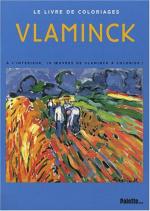|
This section contains 371 words (approx. 2 pages at 300 words per page) |
Encyclopedia of World Biography on Maurice Vlaminck
The French painter Maurice Vlaminck (1876-1958) was one of the great Fauves, artists who stressed the primacy of pure color. In his later work he moved toward a kind of expressive realism.
The son of a Flemish father and a French mother from Lorraine, Maurice Vlaminck was born in Paris on April 4, 1876, and grew up in the suburb of Le Vésinet. Both his parents were musicians, and at the age of 16 Vlaminck moved to Chatou near Paris and earned his living as a violinist and a bicycle racer. In 1894 he married and started a large family. He learned to draw from J. L. Robichon, and at Chatou he worked with Henri Rigal.
Vlaminck was one of the most colorful personalities among French artists. A person of great vitality, he was self-willed, radical, and independent. Very Flemish in temperament, he admired folk art, naive imagery, and African sculpture and was against all schools and academies.
In 1900 the young painter André Derain and Vlaminck shared a studio in Chatou. The decisive event in Vlaminck's artistic development was the large exhibition of Vincent Van Gogh's work in 1901 in Paris. Shortly afterward Vlaminck met Claude Monet and Henri Matisse.
In 1905 Vlaminck, encouraged by Matisse, exhibited at the Salon des Indépendants, at the Berthe Weill gallery, and in the famous "Fauvist zoo" at the Salon d'Automne. Fauve means wild beast, and nobody was wilder in his brushwork and his palette than Vlaminck. Typical canvases of his Fauve period are the Gardens of Chatou (1904), Picnic in the Country (1905), and Circus (1906).
In 1908 Vlaminck's style changed, and under the influence of Paul Cézanne's work he aimed at well-constructed compositions. This is exemplified in Barges (1908-1910) and The Flood, Ivry (1910). About 1915 Vlaminck entered his expressionist phase, characterized by earthy colors and simplified forms. He painted landscapes, portraits, and still lifes with impetuous brushwork. In 1919 a large exhibition of his work took place in Paris.
Vlaminck lived in Anvers-sur-Oise from 1920 to 1925, when he moved to Rueil-la-Gadelière, where he died on Oct. 11, 1958. His late work continued to be in the expressive realist manner. The landscapes, such as Hamlet in the Snow (1943), have a heavily textured brushstroke and are charged with emotion.
|
This section contains 371 words (approx. 2 pages at 300 words per page) |


